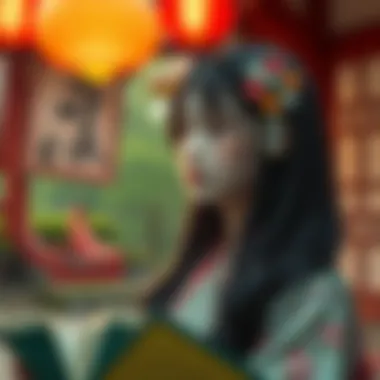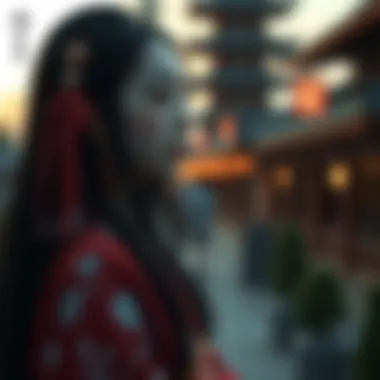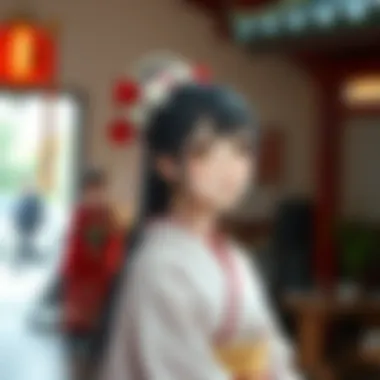Exploring Kaguya: Its Cultural Impact and Modern Views


Intro
The tale of Kaguya embodies a rich tapestry woven from threads of history, mythology, and cultural reflection. Originating from Japan, this story is not just a narrative of a moon princess; it’s a mirror reflecting societal values and aspirations throughout the ages. The story's depth offers more than entertainment; it invites scrutiny into themes of longing, identity, and the essence of humanity itself.
From ancient texts to modern adaptations, Kaguya’s narrative has shifted and transformed, demonstrating its resilience and adaptability in contemporary art forms, especially in anime and beyond. As audiences around the globe engage with this timeless tale, one must ponder its significance in a rapidly evolving cultural landscape. What does Kaguya symbolize in today's world? And how has her story influenced our perspectives on technology, artistry, and the human condition?
An examination of Kaguya's numerous interpretations illuminates its impact on not just Japanese culture but also global media. The evolving portrayals enrich our understanding of character development, visual storytelling, and the dialogues that emerge from this ancient tale. Unraveling these threads can provide a more nuanced appreciation of Kaguya's enduring legacy as we navigate its depths throughout this article.
Intro to Kaguya
The tale of Kaguya, known as "The Tale of the Bamboo Cutter," holds a prominent place within the fabric of Japanese lore. Understanding Kaguya isn't just about recounting a story; it's about grasping cultural nuances and the ancestral wisdom embedded within its narrative. This section sets the stage for a more profound exploration of how this myth has transcended generations, influencing various art forms and forging connections across cultures.
Origins of the Kaguya Myth
The roots of the Kaguya myth can be traced back to the 10th century during Japan's Heian period. It all began with a humble bamboo cutter who discovers a tiny, radiant princess inside a stalk of bamboo. This moment can serve as a metaphor for potential and discovery—how hidden treasures often lie just beneath the surface of the everyday. Notably, Kaguya's origins emerge from a deeply spiritual and naturalistic worldview prevalent at the time, reflecting the human connection to nature.
The myth also harbors cosmic elements; as the story unfolds, it illustrates Kaguya's otherworldly lineage. She originates from the Moon, emphasizing a theme of alienation. This motif resonates within Japanese culture, historically interwoven with beliefs in spirits and celestial beings. To truly appreciate Kaguya's story, it's essential to recognize how its origins serve as a bridge to ancient Japanese consciousness.
The Story's Cultural Relevance
Kaguya is not merely a tale passed down through generations; it is a cultural touchstone that illustrates the societal values of its time. The story deals with fundamental human experiences—love, sacrifice, and the quest for identity. These themes remain troublingly relevant even today. The tale addresses the societal pressures surrounding marriage and the expectations laid upon women. Kaguya, despite her ethereal beauty, yearns for freedom and autonomy, challenging the status quo.
In modern interpretations, Kaguya is often portrayed as a symbol of resilience and independence, appealing to contemporary audiences navigating similar struggles. Her story draws interest beyond Japan, resonating with those who have grappled with issues of identity and personal freedom worldwide.
"Kaguya’s tale reflects how stories shaped cultural identity and norms, prompting readers to reflect on their values and beliefs."
This myth, through various adaptations in anime, literature, and art, invites a robust dialogue about gender, status, and human connection. It serves as evidence that ancient narratives continue to inspire modern storytelling, creating a layered understanding of culture and its evolution over time. By unraveling Kaguya's narrative, we shed light on the societal fabric of Japan, emphasizing how its historical context shapes contemporary interpretations.
Plot Overview of Kaguya
The plot overview serves as a vital compass in the exploration of Kaguya, revealing the intricate hardwood veins beneath the surface of this narrative. With its seemingly simple storyline, it weaves together a rich tapestry of cultural significance and invites varying interpretations across generations. By spotlighting the characters, their relationships, and the overarching themes, one gains insight into the depth of human emotions and societal norms that Kaguya encapsulates. This overview transcends mere summary; it taps into the emotional currents that underscore Kaguya's legacy.
Basic Storyline Elements
At its core, Kaguya's story pivots around the life of a celestial being who descends to Earth in a bamboo stalk. Discovered by an old bamboo cutter, she grows into a remarkably beautiful woman. The narrative chronicles her interactions with society and her eventual longing for her cosmic origin. This progression highlights the themes of transience and identity while anchoring Kaguya as a character caught between two worlds. As readers engage with these basic elements, they’re drawn into a narrative that speaks to existential questions, resonating both with traditional and modern audiences alike.
Character Analysis
Kaguya's Character Traits
Kaguya, the protagonist, embodies a blend of grace and ethereal beauty, coupled with a profound sense of melancholy. Her key characteristic is her ability to evoke empathy from those around her. From the moment she appears in the bamboo cutter's life, her presence alters trajectories, leading to unanticipated consequences for both herself and others. This trait is not only beneficial for the narrative, but also enhances engagement amongst readers, driving them to contemplate the complexities of Kaguya’s existence.
A unique feature of Kaguya's character is her intrinsic duality. On one hand, she represents an unattainable ideal, captivating suitors vying for her affection; on the other, she experiences a deep sense of alienation from the very human interactions she seems to attract. This tension offers a poignant commentary on the difficulty of belonging, a thread that resonates profoundly in contemporary contexts. It raises questions about the price one pays for beauty and the sacrifices involved in seeking true fulfillment.
The Role of the Bamboo Cutter


The bamboo cutter, Kaguya’s adoptive father, serves a critical function in the story, highlighting the dynamics of family and nurture. His initial discovery of Kaguya sets the entire narrative in motion, grounding the mythical aspects of the tale in the reality of human emotions. His character is not just a caretaker but also reflects the struggle between personal desire and paternal duty, representing different layers of love and sacrifice.
One noteworthy aspect of the bamboo cutter is his evolution throughout the story. As Kaguya grows, her father becomes increasingly aware of her true nature and the inevitable separation looming ahead. This feature adds a layer of poignancy, overshadowing moments of joy with an impending sense of loss. His role underscores a broader commentary on the responsibilities of parenting, and how these relationships shape one’s identity.
Significance of the Suitors
The suitors in Kaguya’s narrative serve not merely as romantic foils but as embodiments of societal expectations and the various aspirations of men. Each suitor represents different facets of ambition, ranging from the absurd to the noble, providing a critical lens through which to examine gender roles and societal pressures. Their pursuit of Kaguya not only sheds light on the nature of love but also reveals the folly of human pride and ambition.
What stands out is how these characters, by their very nature, illuminate Kaguya's position as an object of desire. This dynamic emphasizes the story's tension between love and materialism, questioning the authenticity of affections based on superficial attributes. The failed attempts of the suitors to win Kaguya's heart serve as a cautionary tale, warning against the shallow pursuits that overlook profound emotional connections.
Thus, the characters around Kaguya are as significant as the protagonist herself, serving to explore deeper themes of longing, aspiration, and the human condition. The interplay between Kaguya and her suitors opens a critical discourse on the nature of relationships, making it clear that Kaguya is not merely a passive figure, but a catalyst for reflection on societal norms.
"Kaguya's narrative challenges the reader to reflect on the deeper truths of existence, questioning not only who we love, but also how we understand love itself."
Engaging with the plot and character elements of Kaguya provides a comprehensive look at the story’s richness. It connects the past to the present, allowing contemporary audiences to find a mirror reflecting their own understanding of love, identity, and societal roles.
Themes Explored in Kaguya
The significance of the themes within the narrative of Kaguya serves as an essential thread that weaves together its rich tapestry. These themes not only reflect the cultural values and existential ponderings of its time but also resonate deeply in today’s society. As the characters navigate their journeys, they mirror the human experience, bringing forth ideas that echo throughout generations. Analyzing the themes of transience and impermanence, love and sacrifice, as well as identity and alienation enriches our understanding of Kaguya, allowing us to draw connections between the past and the present.
Transience and Impermanence
At the heart of Kaguya’s tale lies the theme of transience and impermanence. The fleeting nature of beauty and life encapsulated in Kaguya’s existence serves as a poignant reminder of life’s ephemeral qualities. The way her character is portrayed—glimmering like a moonbeam but destined to vanish—can be linked to the Buddhist concept of mono no aware, which emphasizes the beauty found in the temporary nature of all things.
Kaguya’s return to the moon symbolizes an eternal cycle, acquiring both a sense of loss and acceptance in the minds of her suitors and the audience alike. The story unfolds not just as a simple folk tale, but as a reflection on how every moment is cherished until it slips away. This resonates on various levels, stirring emotions as we confront our own realities of growth and loss.
"The poignant sadness of beauty can provoke deep reflections on our own fleeting moments."
Love and Sacrifice
The delicate dance between love and sacrifice is another profound theme explored within Kaguya. Each suitor, from the bamboo cutter to the noblemen, embodies varying expressions of love, portrayed through their willingness to vie for Kaguya's affection. This ardor, however, pushes them through trials that test their character and motives, generating an atmosphere thick with tension.
Yet the narrative ultimately poses a question: how far does one go for love? Kaguya’s own sacrifice—returning to the moon and abandoning the world she grew to know—highlights the complexities of love that transcend personal desires. It raises the moral dilemma of selflessness versus selfishness, which reverberates in real-world relationships.
Kaguya's departure showcases that true love may not always be about possessing the one you cherish, but rather letting them go when it’s for their greater good.
Identity and Alienation
Kaguya's struggle with her identity and feelings of alienation further illustrate a deeply nuanced character living between two worlds. As a celestial being amidst villagers, she often finds herself at odds with her intrinsic nature and the expectations imposed upon her by society.
This theme resonates with many who feel the weight of societal norms pressing on their identities—whether through cultural expectations or personal aspirations. Kaguya’s profound sense of isolation raises important discussions about belonging and self-acceptance. In an age where individuality is often celebrated, the struggles of Kaguya reflect the lasting challenge of reconciling one’s true self with external influences.
In summary, the themes coursing through Kaguya’s narrative reveal much about the human experience, prompting reflection on impermanence, love, sacrifice, and identity. By grappling with these notions, both the characters and the audience engage in a timeless dialogue about our existence—making Kaguya not simply a story of an ethereal princess but rather a shared human narrative that leaves an indelible mark.
Kaguya in Contemporary Media


As Kaguya's narrative continues to weave its way through the fabric of modern storytelling, the realm of contemporary media plays a pivotal role in both preserving and reinventing this age-old tale. The significance of Kaguya in anime and manga reflects broader themes of identity, love, and transience, which continue to resonate within modern culture. This section aims to illuminate how Kaguya’s presence in modern media has allowed for new interpretations and adaptations, reinforcing its cultural viability and relevance across generations.
Anime Adaptations
Notable Anime Series
Several anime adaptations have brought Kaguya’s story to a wider audience, each bringing a unique flavor and perspective to the tale. One of the most notable adaptations is The Tale of the Princess Kaguya, directed by Isao Takahata and produced by Studio Ghibli. This series stands out due to its hand-drawn animation style, offering a visual experience that feels almost painterly, recalling traditional Japanese art forms. Its ethereal quality not only captures the beauty of Kaguya herself but also resonates with the themes of nature and impermanence – key elements of the original myth.
The use of watercolor techniques sets this adaptation apart, showcasing the delicate variations in emotion as Kaguya navigates her relationships. This artistic choice emphasizes the surreal nature of her existence, giving viewers an immersive experience with rich landscapes and emotive character design. However, while this adaptation is acclaimed for its artistry, some critiques arise from its slower pacing, which may deter those seeking more action-centric narratives. This highlights the balance in adapting Kaguya’s story: while the visual and emotional depth is profound, accessibility matters as well.
Artistic Interpretations
The artistic interpretations of Kaguya in anime push the boundaries of visual storytelling, allowing creators to explore contemporary themes through a traditional lens. Different series adopt varying styles that reflect societal changes and artistic movements. For instance, the 2021 series Kaguya-sama: Love Is War introduces a significant departure from the classic narrative. While it holds on to core elements of love and societal expectation, it cleverly weaves them into a comedic, battle-of-wits format.
This unique approach highlights the complexity of modern relationships, echoing Kaguya's internal struggles with her identity and her choices. The sharp dialogue and vibrant, exaggerated art style are entertaining yet thought-provoking, drawing in young audiences who might resonate more with the comedic aspects of love rather than the more direct, poignant sadness found in the original tale.
This adaptation's ability to encapsulate the romantic tension while steering clear of overly sentimental narratives showcases the creative opportunities available when reinterpreting Kaguya. However, such liberties may lead to dilution of the profound themes originally present, sparking debates among purists and new fans alike about the fidelity to the source material.
Manga Representations
Manga has also embraced the Kaguya narrative, reflecting its multifaceted cultural significance through various series. These representations tap into Kaguya's themes of sacrifice, identity, and societal expectations, often enhancing them with modern contexts. Manga series like Kaguya-hime modernize the tale while remaining true to its roots, allowing readers to explore these themes in a format that speaks to contemporary issues.
In addition, manga adaptations often incorporate elements such as humor or fantasy, further enabling a broader audience to connect with Kaguya. A notable example is Kaguya-sama: Love Is War, discussed in the anime section, also originating from manga. Here, the balance of romantic and comedic tension speaks well to readers navigating complex relationships in today’s world.
Furthermore, the visual language in manga adds layers to Kaguya’s character and story arc, allowing for a deeper exploration of the internal conflicts she faces, often depicted through expressive illustrations that resonate with readers emotionally. This duality between Kaguya's serene exterior and turbulent inner world reflects the challenges of modern existence, proving that Kaguya continues to engage and inspire audiences even decades after her story was first told.
Technological Innovations and Kaguya
The convergence of technological innovations and the Kaguya narrative is a compelling aspect that sheds light on how traditional stories can be reshaped through modern means. In an age where technology serves as the backbone of much of our daily interactions, it has also offered new avenues for storytelling, particularly for age-old tales like Kaguya. By examining technological advancements that enhance our engagement with Kaguya, we discover how they breathe new life into this timeless story, allowing it to resonate with contemporary audiences.
Anime Applications and Their Role
Mobile Apps Enhancing Engagement
The use of mobile applications related to Kaguya has added a layer of interactivity that simply wasn’t available in earlier interpretations. These apps allow users not just to consume the story, but to actively engage with it in a myriad of ways. For instance, an app may provide exclusive content, interactive character dialogues, and even AR features that let users explore the lush environments from the tale.
The key characteristic of these mobile apps is their interactivity, which makes them a powerful choice for engaging younger audiences. With everything from games to narrative-driven experiences, mobile apps successfully merge play with storytelling. A unique feature is often the personalized experience, where choices can influence story outcomes, allowing for a tailored engagement that draws users deeper into Kaguya’s world. While these apps generally come with the advantage of accessibility, they sometimes lack the richness of storytelling found in traditional formats, which can be a limitation for purists.
Streaming Platforms and Accessibility
Streaming platforms have revolutionized how we consume media, including adaptations of Kaguya. They provide an accessible avenue for audiences worldwide, ensuring that even those far from Japan can experience this beloved tale. With just a few clicks, viewers can access various adaptations, from animation to live-action films, all in the comfort of their own homes.
The core benefit of streaming platforms lies in their immediacy. Viewers can watch what they want, when they want, without the need for physical copies or scheduled broadcast times. This immediacy can lead to increased viewership, which is crucial for maintaining a cultural narrative. A notable feature is the global availability of subtitles and dubbing in multiple languages, making the story accessible to non-Japanese speakers. Though there can be concerns about piracy and the impact on traditional cinema, the advantages of increased availability and audience reach far outweigh the negatives.
Gamification of the Kaguya Experience


Gamification has emerged as a significant tool for enriching the Kaguya narrative. By integrating game elements into storytelling, creators can amplify engagement and make the experience more interactive. This could involve simple mobile games centered on Kaguya, where players solve puzzles or embark on quests related to the story.
Such gamified experiences not only entertain but also educate. Users gain a deeper understanding of Kaguya's themes and characters while enjoying a captivating gameplay experience. However, this innovation doesn't come without its drawbacks. The challenge lies in balancing entertainment with the preservation of the story's essence. Ensuring that the game aspect complements rather than distracts from Kaguya's profound message requires careful consideration and creativity in design.
"Technology has the power to connect audiences with narratives in ways previously unimaginable. Kaguya, through these innovations, continues to evolve and inspire in the digital age."
The interplay between technological innovations and Kaguya demonstrates how traditional tales can be revitalized for new generations. As technology continues developing, it is fascinating to anticipate how future adaptations of Kaguya will emerge, shaping cultural discussions and reflections along the way.
The Global Impact of Kaguya
Kaguya's influence extends far beyond its origins as a folk tale in Japan. This tale has woven itself into the global tapestry of culture, affirming its importance in both traditional and contemporary contexts. Its deep-seated themes resonate across borders, connecting with people from diverse backgrounds. Kaguya's narrative not only reflects societal values but also engages audiences with its emotional depth and artistic beauty. Understanding the global impact of Kaguya allows us to appreciate how a single story can inspire various interpretations, adaptations, and cultural exchanges.
International Reception of Kaguya
The reception of Kaguya around the world illustrates the universal appeal of its themes. When Studio Ghibli adapted Kaguya into The Tale of the Princess Kaguya, it was met with both critical acclaim and popular success. The animation captivated audiences with its unique art style, reminiscent of traditional Japanese wash painting, while its narrative captured the essence of the original folktale. Viewers found themselves immersed in Kaguya's world, where feelings of isolation, longing, and love were vividly portrayed.
Critics noted the film's subtle social commentary and emotional resonance. The juxtaposition of Kaguya's celestial origins against the backdrop of earthly desires prompted discussions about identity and belonging. As the film made its way to international film festivals, it garnered numerous awards, emphasizing not just its artistic merit but also its overarching message about humanity's connection to the ephemeral nature of life.
Other adaptations, whether in manga or anime, further spread Kaguya’s influence. For example, references in various shoujo manga illustrate how Kaguya's themes have found a home in romantic narratives, appealing particularly to younger audiences. The tale's elements of transcending societal norms can be found echoing in different forms of storytelling throughout the globe.
Cultural Exchange and Adaptation
The story of Kaguya exemplifies the beauty of cultural exchange. Adaptations in the West often strip the narrative to its essence, exploring themes of loss and self-discovery through reincarnated and re-imagined plot lines. Kaguya: Princess of the Moon is one such retelling, blending elements from the original while infusing it with contemporary values. This cultural dialogue allows the story to retain its core while simultaneously speaking to a modern audience.
Moreover, the burgeoning interest in anime and Japanese culture has invigorated Kaguya's discourse in academia and creative circles alike. Workshops and symposiums discussing the narrative's implications and adaptations are increasingly common.
Cross-cultural exhibitions highlight the narrative’s enduring relevance, showcasing art and performances inspired by Kaguya in international art festivals. These events not only honor the tale’s heritage but also shed light on its influence across various artistic expressions.
“Kaguya teaches us that while roots define us, growth transcends boundaries.”
Explore further by visiting Wikipedia on Kaguya or dive into discussions at Reddit about its modern adaptations.
Ending: Kaguya's Enduring Legacy
The conclusion serves as a pivotal point for summarizing not only the multifaceted narrative of Kaguya but also its broader implications in society today. Kaguya's tale, steeped in ancient wisdom and emotion, holds a mirror to the human experience. The relevance of Kaguya stretches beyond a mere story; it's a canvas reflecting various cultural expressions and interpretations throughout time.
Reflections on Modern Interpretations
Modern interpretations of Kaguya are woven into the very fabric of contemporary media. Filmmakers and animators have taken the essence of the original story and infused it with fresh perspectives. For example, Studio Ghibli's adaptation showcases not only Kaguya's ethereal beauty but also her struggle against societal expectations. It prompts reflections on autonomy, a topic that resonates with current discourse surrounding individual rights and self-expression.
Moreover, social media platforms and fan communities have driven conversations about Kaguya's character traits, encouraging analysis and debate. Here, Kaguya transforms from a silent figure to a symbol of resistance against normative values. As audience members resonate with her plight, discussions spill over from forums like Reddit to dedicated blogs and vlogs, creating a vibrant tapestry of modern reinterpretations, each adding their unique brushstroke to the broader narrative.
"Kaguya is not just a story from the past; it is a living poem, evolving with each generation's retelling."
Future Directions in Kaguya's Representation
Looking ahead, Kaguya's representation is poised for further evolution, spurred by advancements in technology and storytelling techniques. The rise of virtual reality could offer audiences immersive experiences, allowing them to step into Kaguya's shoes, feeling the weight of her choices firsthand.
As we delve deeper into globalization, Kaguya may find her story interwoven with various cultures, leading to adaptations that merge her traditional Japanese roots with diverse influences. This cross-cultural exchange can breathe new life into the original narrative, resulting in stories that cater to an array of perspectives.
In addition, collaborations between creators from different backgrounds provide fertile ground for innovative storytelling. Indeed, platforms like Netflix and Hulu are already exploring international cinema in ways previously unimagined. With these shifts in the landscape, Kaguya's legacy stands not only as a traditional narrative but also as a framework for future explorations, ensuring that her story continues to inspire and evolve.















